Physical Address
304 North Cardinal St.
Dorchester Center, MA 02124
The vitreous, a transparent gelatinous structure that fills the posterior four-fifths of the globe, is firmly attached to the pars plana and loosely to the retina and optic nerve posteriorly. In childhood there is a firm attachment to the lens.
The development of the vitreous body and zonule can be divided into three stages:
The primary vitreous is formed during the first month of gestation and is a vascularized mesodermal tissue separating the developing lens vesicle and the neuroectoderm of the optic cup. It contains branches of the hyaloid artery that later regress.
The secondary vitreous starts at 9 weeks and develops throughout embryonic life. It forms the vitreous body, is avascular and transparent, and displaces the primary vitreous, which becomes Cloquet's canal, running from the optic disc to the lens. By the third month, the secondary vitreous fills most of the developing vitreous cavity.
The tertiary vitreous lies between the ciliary body and lens, separated from the secondary vitreous as well-formed fibrils, which later develop into the zonule.
Persistence of the primary vitreous or part of its structure may give rise to a number of congenital abnormalities.
Persistence of all, or more frequently part, of the hyaloid artery is a common congenital abnormality. Hyaloid artery remnants occur in 3% of full-term infants but are commonly seen in premature infants, during screening examinations for retinopathy of prematurity ; most regress in early infancy. Rarely, the whole artery may run from the disc to the lens. Posterior remnants may give rise to a single vessel running from the center of the disc or to an elevated bud of glial tissue – Bergmeister's papilla. Anterior remnants of the hyaloid system may be seen as a small white dot on the posterior lens capsule – Mittendorf's dot. These remnants are non-progressive and do not interfere with vision.
Acquired cysts may occur with inflammatory disease and, rarely, with X-linked retinoschisis. Congenital cysts are usually found in otherwise normal eyes. Their origin is unknown but, as blood vessels are sometimes seen within them, they may develop from hyaloid artery remnants. Some cysts are pigmented and it has been suggested that pigmented cysts may arise from the retinal pigment epithelium.
Cysts may lie in the vitreous immediately behind the lens ( Fig. 41.1 ) or in the posterior vitreous. They may be mobile or attached to the lens or optic disc. Mostly, intervention is not required but laser treatment (Nd:YAG, argon or diode laser) may be used to collapse the cyst if it is symptomatic. However, repeat Nd:YAG therapy of an anterior pigmented cyst has resulted in a cataract. Large symptomatic cysts that do not respond to laser may require excision via a pars plana vitrectomy approach.
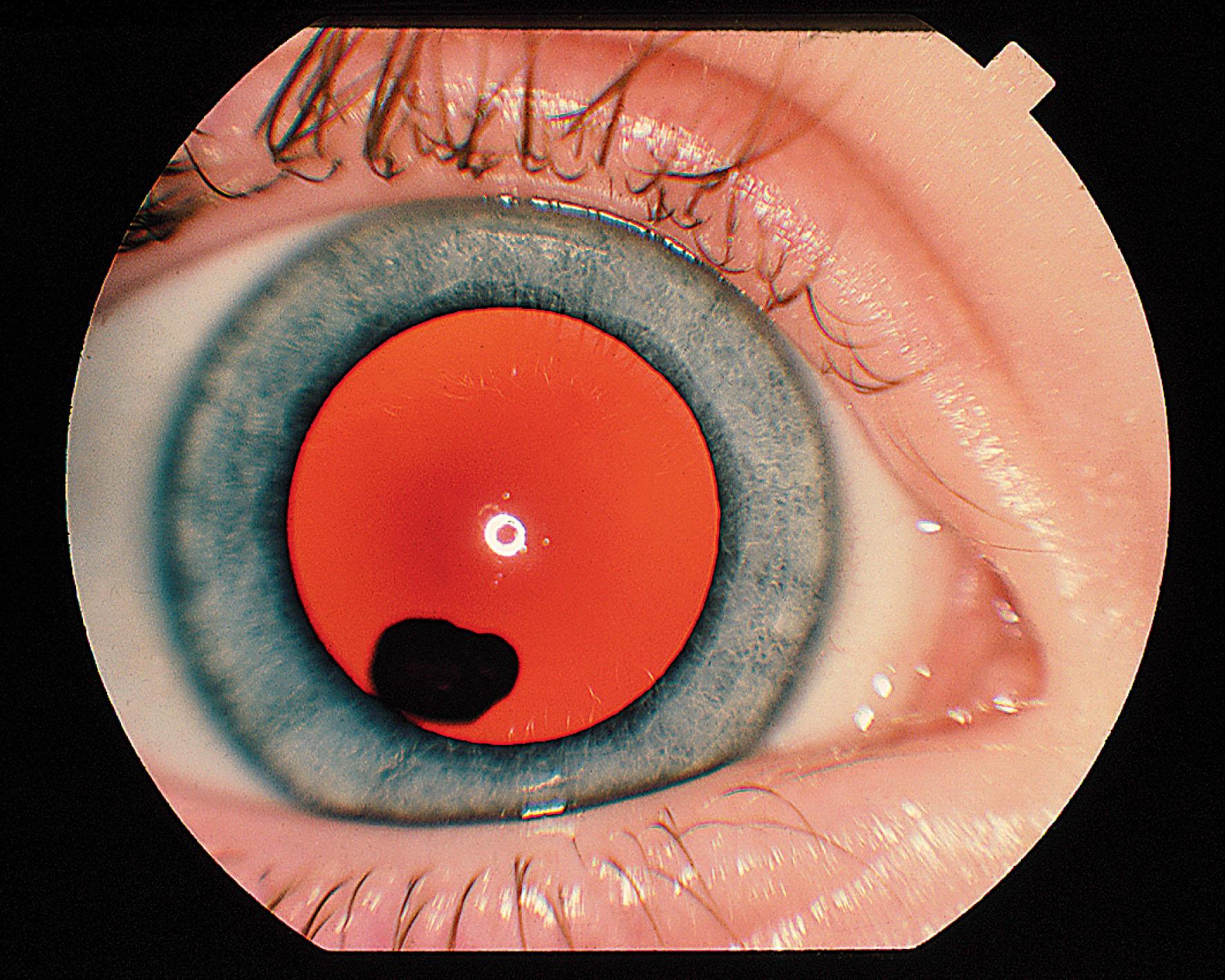
Persistent fetal vasculature (PFV), also referred to as persistent hyperplastic primary vitreous (PHPV), is caused by failure of the primary vitreous to regress. Most cases are sporadic and unilateral, but there may be minor abnormalities in the fellow eye. The affected eye is often mildly microphthalmic. PFV may be predominantly anterior (anterior PFV), confined to the posterior segment (posterior PFV), or less commonly involve both anterior and posterior segments. Anterior PFV is discussed in detail in Chapter 34 and will not be considered further here.
In posterior PFV, the ocular abnormality is confined to the posterior segment, and may present with leukocoria, strabismus, microphthalmia, or nystagmus. Most cases are unilateral; bilateral and familial cases have been reported but these are likely to represent cases of vitreoretinal dysplasia (see below). The lens is usually clear. There is often a fold of condensed vitreous and retina running from the optic disc to the ora serrata or lens ( Fig. 41.2 ), often associated with a localized retinal detachment. Other associated abnormalities include epiretinal membrane, vitreoretinal traction, and foveal maldevelopment. The diagnosis is usually apparent when a careful examination is performed, under anesthesia if necessary, but ultrasound and computed tomography (CT) imaging help in differentiating PFV from retinoblastoma in cases where the diagnosis is uncertain (see Chapter 42 ). Mild cases can be observed without treatment but in cases with associated retinal detachment or extensive epiretinal membrane distorting the fovea, lens-sparing vitreoretinal surgery may be indicated. Early surgery, although technically more challenging, is preferable to allow early treatment of associated amblyopia. It is possible to relieve vitreoretinal traction and reattach the associated retinal detachment, but in most cases the postoperative visual acuity is 20/200 or worse.
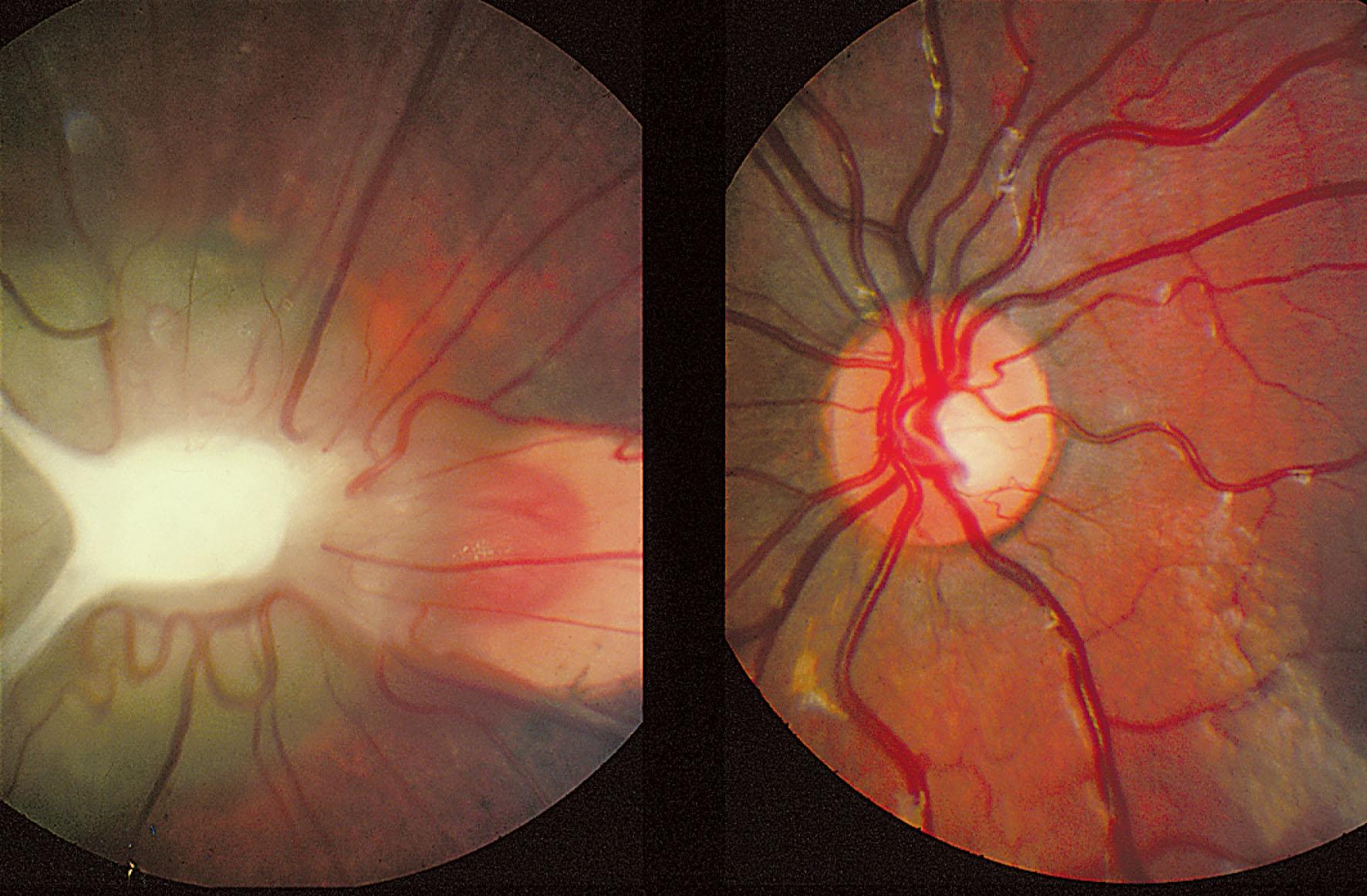
Maldevelopment of the vitreous and retina, vitreoretinal dysplasia, is seen either as an isolated ocular abnormality or more commonly associated with systemic abnormalities either as a result of monogenic disease or a chromosomal abnormality. In syndromic forms of retinal dysplasia there is usually bilateral involvement. There appears to be no relationship between the histologic findings and the various syndromes in which retinal dysplasia is reported. The dysplastic retina contains rosettes that resemble retinoblastoma rosettes but contain Müller cells with an abnormal relationship between the retina and retinal pigment epithelium (RPE).
Norrie disease is an X-linked recessive disorder associated with disease-causing variants in the NDP gene. Affected males are blind at birth or in early infancy due to bilateral retinal dysplasia. Some affected males are developmentally delayed and about one-third later develop cochlear deafness, usually starting in late teenage years. Other medical problems may become apparent over time, including seizure disorders, autism, and peripheral vascular disease. A more severe systemic phenotype is seen in patients with large chromosomal deletions encompassing the Norrie gene locus. Ocular findings include bilateral cataracts, bilateral retinal folds, retinal detachment, vitreous hemorrhage, and bilateral vitreoretinal dysplasia ( Fig. 41.3 ). The retinal detachments are usually present at birth and have been observed in utero by ultrasonography. Most cases progress to an extensive vitreoretinal mass and bilateral blindness. Angle closure glaucoma may develop; this is best managed by lensectomy. Late signs include corneal opacification, band keratopathy, and phthisis bulbi (see Fig. 41.3 ).
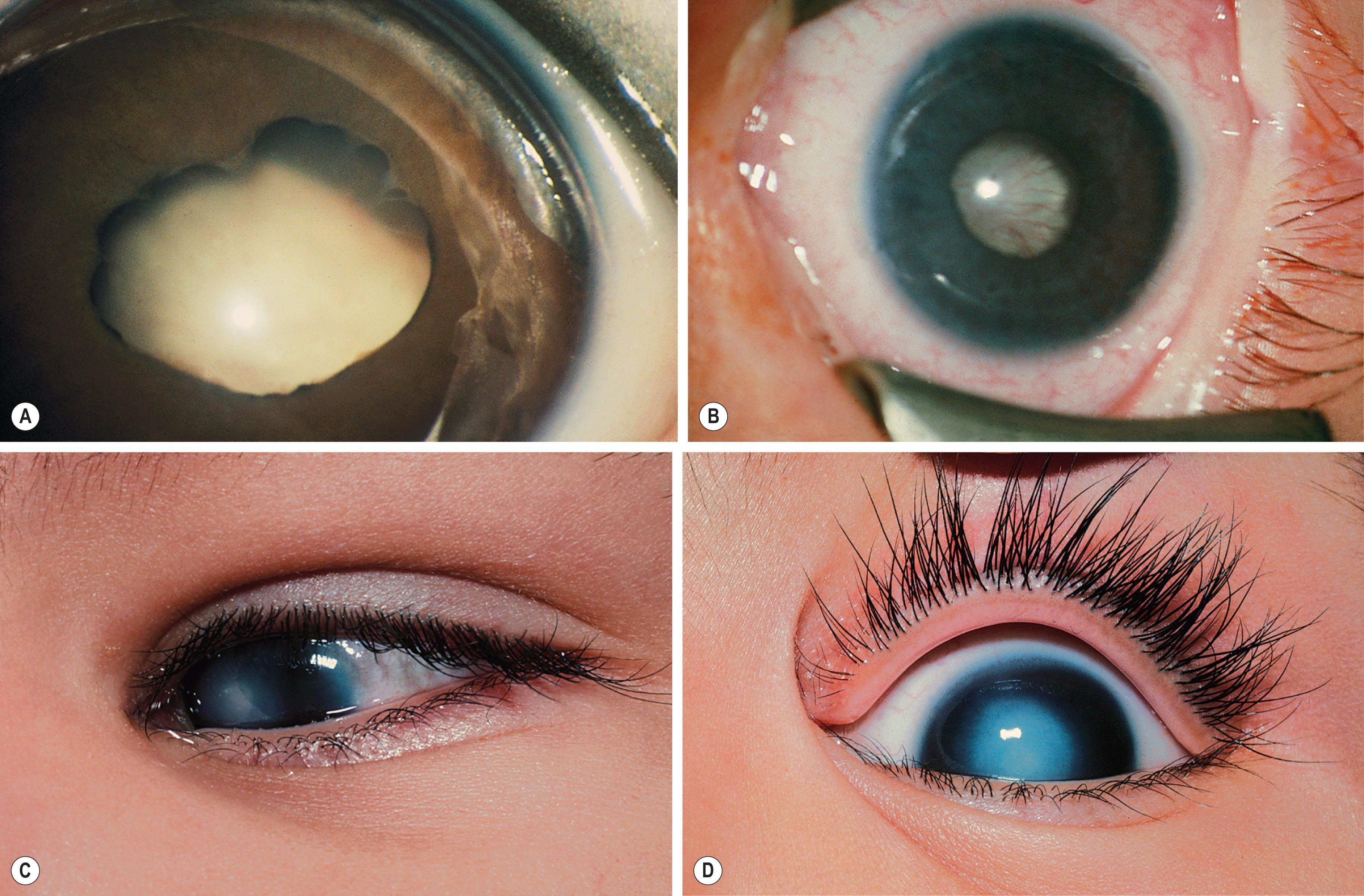
Carrier females do not usually show any ocular abnormality or electroretinography abnormalities, but symptomatic carriers have been rarely reported. One affected female born to a carrier mother had a retrolental mass in the right eye and a retinal fold with a tractional retinal detachment in the left. Molecular genetic testing confirmed that she was a manifesting heterozygote. She had skewed X-inactivation in her peripheral blood lymphocytes, suggesting non-random X inactivation, with inactivation occurring more frequently in the normal rather than the mutant X chromosome. A female with Norrie disease with an X autosome translocation has also been described.
More than 100 disease-causing variants have been identified in the Norrie disease gene NDP . A variety of variants have been reported including missense, splice site, nonsense, and deletions. There is no clear genotype–phenotype correlation for intragenic variants, but patients with contiguous gene deletions have a more severe extraocular phenotype. The encoded protein, Norrin, is a key component of the Wnt signaling pathway which plays an important role in the development of the anterior and posterior segment and is especially important in retinal vascular development ; abnormal Wnt signaling may result in other retinal disorders including familial exudative vitreoretinopathy and the osteoporosis–pseudoglioma syndrome (see later sections). The association of Norrie disease with peripheral vascular disease is evidence for a role of the NDP gene in extraocular angiogenesis.
Missense variants in NDP are associated with another rare vitreoretinal disorder, X-linked familial exudative vitreoretinopathy (see below). There is also evidence that Coats disease may be caused by a somatic variant in NDP in the retina of affected eyes, resulting in a deficiency of Norrin, with consequent abnormal retinal vascular development, the hallmark of Coats disease (see Chapter 48 ).
The role of NDP in retinopathy of prematurity (ROP) is controversial. Some case–control studies have suggested that sequence variants in NDP may predispose to stage 5 ROP; other studies have been negative. These studies have involved small numbers of subjects and the controversy will not be resolved until larger studies have been performed.
Ndp knock-out mouse models have a similar ocular phenotype to humans, with fibrous masses in the vitreous cavities, disorganization of retinal ganglion cells, and sporadic degeneration of other retinal cell types. The mouse model shows early abnormalities in retinal vascular development. This is further evidence for disordered retinal vascular development being the primary cause of the retinal detachment in Norrie disease. As in humans, these mice have progressive hearing loss leading to profound deafness, with abnormal vasculature and eventual loss of most of the vessels in the stria vascularis (the main vasculature of the cochlea), suggesting a principal function of Norrin in regulating the interaction of the cochlea with its vasculature.
In most cases of Norrie disease, affected males have bilateral total retinal detachment from birth and vitreoretinal surgery is not indicated. Lensectomy may be indicated when there is shallowing of the anterior chamber and a risk of pupil-block glaucoma. It is important that children and their families have good educational and social support, and are referred for genetic counseling to discuss the risk of further affected pregnancies. Molecular diagnosis is possible in the majority of cases and prenatal or pre-implantation diagnosis is possible where the causative sequence variant is known. Early delivery of a fetus known to carry a Norrin variant followed by antivascular endothelial growth factor (VEGF) and laser treatment of the retina was shown to result in a good outcome with normal foveal structure. This suggests that in some families who choose this option, prenatal diagnosis, preterm delivery, and prompt laser treatment may prevent retinal detachment.
Vitreoretinal dysplasia alongside other congenital abnormalities have been described in a number of chromosomal abnormalities including trisomy 13, trisomy 18, 20 q deletion, and duplication of 5q.
Trisomy 13 (Patau syndrome) is the chromosomal abnormality most consistently associated with severe ocular defects. Systemic abnormalities include microcephaly, cleft palate, congenital cardiac defects, polydactyly, skin hemangiomas, umbilical hernia, and malformation of the central nervous system. Most children die within the first few months of life.
Bilateral ocular abnormalities are common in trisomy 13 and are detailed in Box 41.1 . In some cases there is total disorganization of the vitreous and retina; extensive retinal dysplasia is evident histologically.
Microphthalmos/anopthalmos
Coloboma of the uveal tract
Cataract
Corneal opacities
Congenital glaucoma
Retinal dysplasia
Persistent fetal vasculature
Dysplastic optic nerves
Cyclopia
The acronym “HARD ± E” stands for hydrocephalus, agyria, retinal dysplasia, with or without encephalocele ( Fig. 41.4 ). This autosomal recessive syndrome is characterized by type II lissencephaly, retinal dysplasia, cerebellar malformation, and congenital muscular dystrophy. Hydrocephalus is common. Other variable features of the Walker–Warburg syndrome (WWS) include Dandy–Walker malformation and encephalocele. Neonatal death is common and survivors are severely developmentally delayed. The ocular features in this disorder are variable and include microphthalmia, Peters anomaly, cataract, retinal coloboma, incomplete retinal vascularization, and retinal dysplasia.
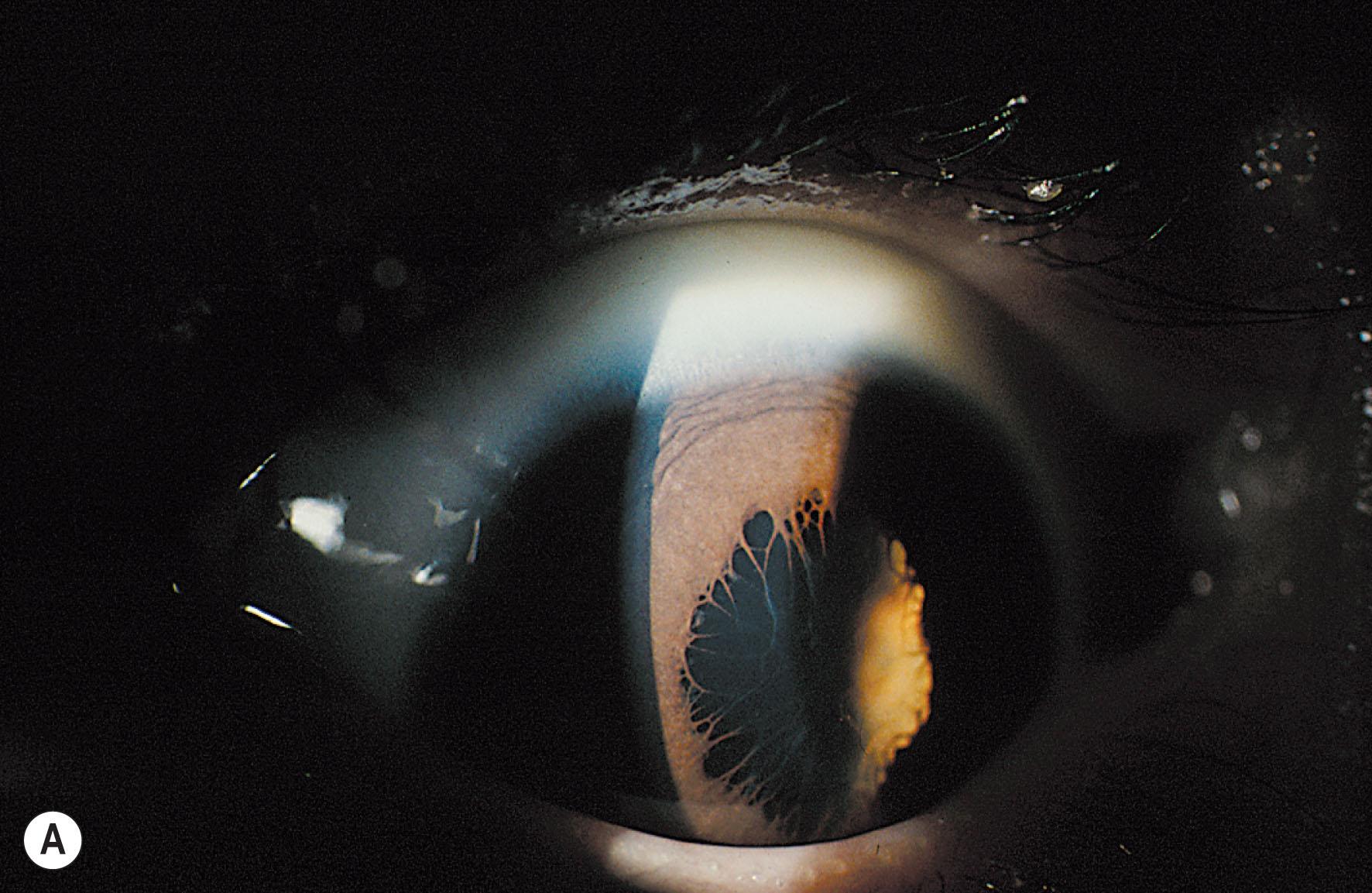
Other rare autosomal recessive disorders characterized by the combination of congenital muscular dystrophy and brain malformations include muscle–eye–brain (MEB) disease and Fukuyama congenital muscular dystrophy (FCMD). Ocular abnormalities are a constant feature in MEB and WWS, but not in FCMD.
Next generation sequencing has revolutionized the molecular diagnosis of WWS and related phenotypes; the disorders are highly heterogeneous with biallelic disease-causing variants in 18 genes identified to date. Variants in these genes result in defective α-dystroglycan, a key protein in muscle structure and also in neuronal migration in brain development.
Vitreoretinal dysplasia may occur as an isolated abnormality in a healthy child. The inheritance is presumed to be autosomal recessive. In male infants, disease-causing variants in the Norrie disease gene ( NDP ) must be excluded. Presentation is with bilateral poor vision in early infancy, a shallow anterior chamber, and white retrolental mass. Progressive shallowing of the anterior chamber can result in pupil-block glaucoma, which may require lensectomy.
Recently a homozygous variant in the ATOH7 gene has been reported in a consanguineous Pakistani family with autosomal recessive vitreoretinal dysplasia (described as bilateral PHPV) and evidence of bilateral optic nerve aplasia on MRI scan. ATOH7 is a key protein in specifying ganglion cell fate.
This autosomal recessive syndrome is characterized by osteoporosis, severe learning difficulties, and vitreoretinal dysplasia ( Fig. 41.5 ). Multiple fractures, often after minor trauma, are commonplace. Affected children present in infancy with bilateral nystagmus and severe visual impairment; the systemic features occur in later infancy and childhood. Ocular features include vitreoretinal dysplasia with retrolental masses, microphthalmia, anterior chamber anomalies, cataract, and phthisis bulbi. Most patients are blind from birth, but a few patients have useful vision into their teenage years. Referral to a bone specialist is essential as early treatment with bisphosphonates can increase bone density and possibly reduce the frequency of fractures.
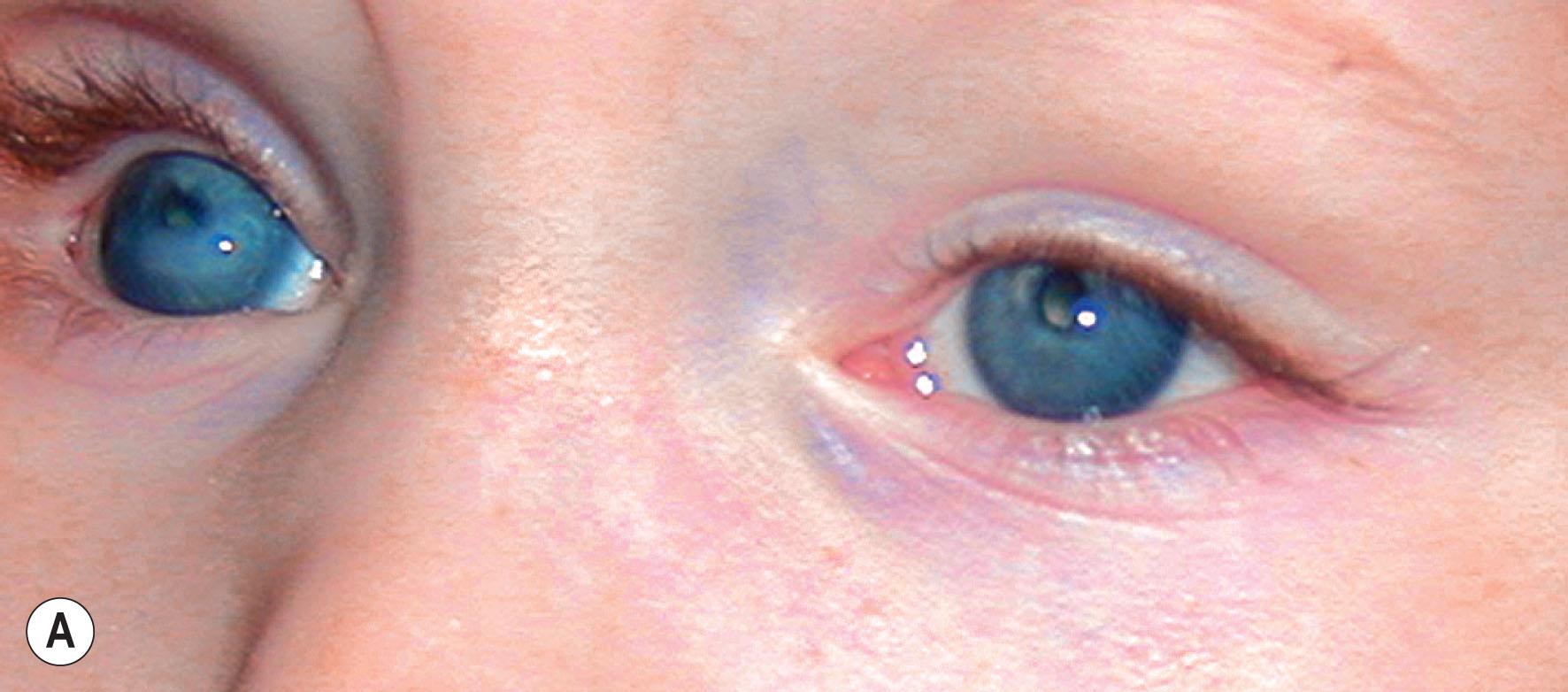
OPS is associated with disease-causing variants in the gene encoding the low-density lipoprotein receptor-related protein 5 ( LRP5 ). Variants in LRP5 have also been implicated in both autosomal recessive and autosomal dominant familial exudative vitreoretinopathy (FEVR). These patients have also been shown to have reduced bone mineral density, suggesting that osteoporosis–pseudoglioma syndrome and LRP5 -associated FEVR are part of a single phenotypic spectrum with both ocular and bone manifestations.
Studies of LRP5 indicate that it affects bone accrual during growth by regulating osteoblastic proliferation. Furthermore, LRP5 is a component of the Wnt signaling pathway, regulating retinal development and angiogenesis. Disease-causing variants in this gene result in disordered retinal vascularization.
Three siblings of consanguineous parents were described with vitreoretinal dysplasia and systemic abnormalities including microcephaly, developmental delay, cleft palate, and short stature. The ocular abnormalities, similar to those seen in PFV, were bilateral in one child and unilateral in the others. It is likely inherited as an autosomal recessive trait.
Lloyd et al. reported a family in which three affected members had unilateral retinal dysplasia without any systemic abnormalities.
Become a Clinical Tree membership for Full access and enjoy Unlimited articles
If you are a member. Log in here